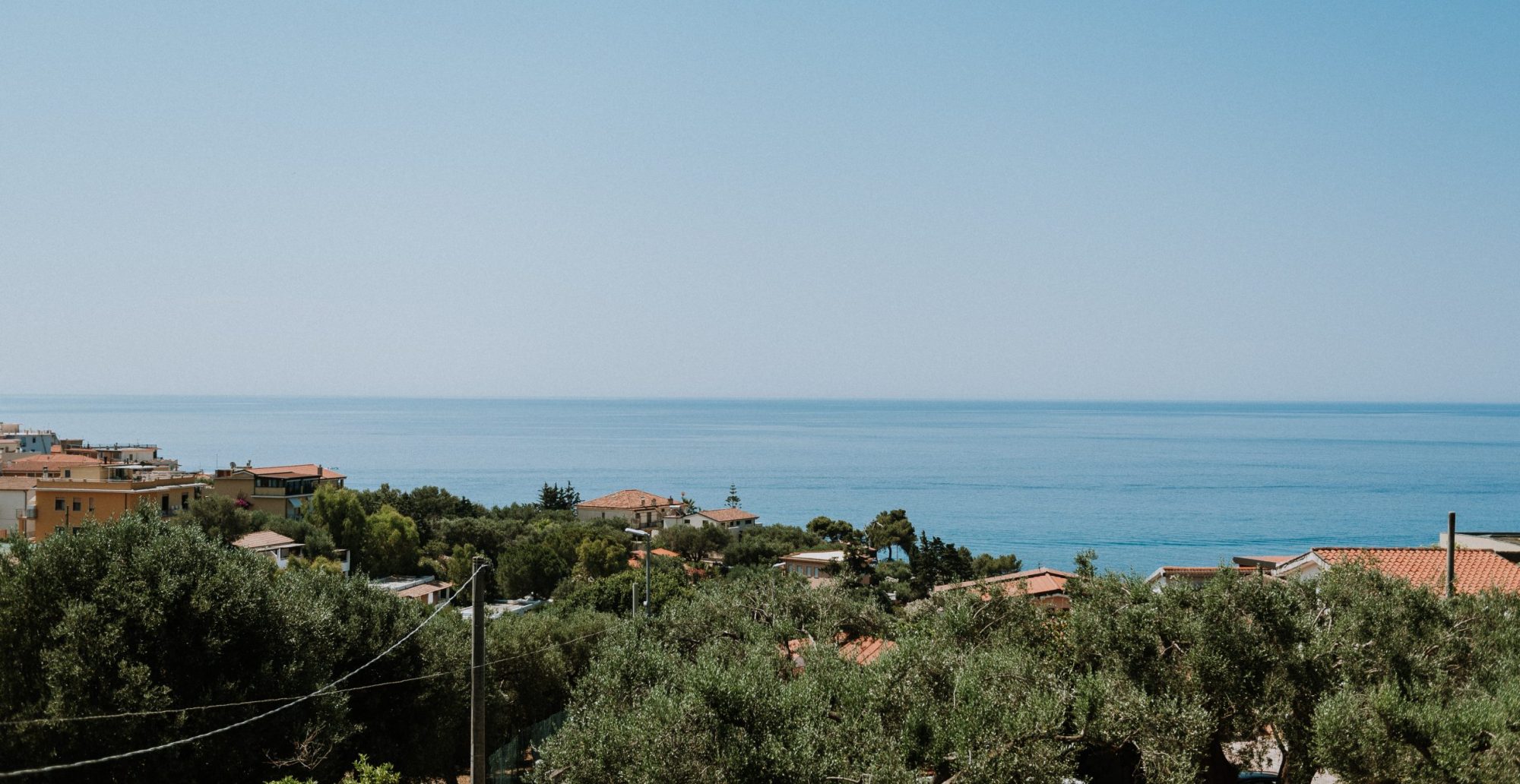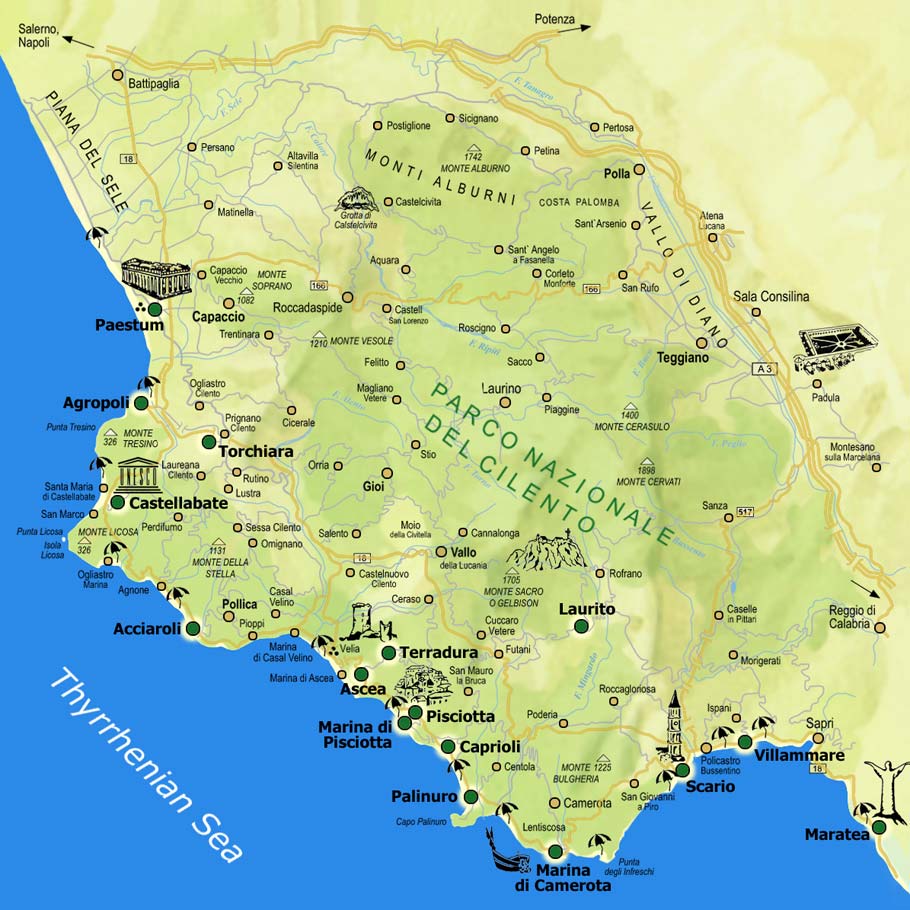The most beautiful beaches of Cilento
The village of Marina di Camerota (“La Perla del Cilento”) is located within the Cilento and Vallo di Diano National Park, which is now a World Heritage Site. Here nature is the protagonist, its wonderful beaches, the flora and fauna are witnesses of the unique biodiversity of this area rich in exemplary species.
The sea of crystalline transparency, the intense blues of the protected marine area, coves and caves characterize this promontory and depict the epic scenery of “La Costa del Mito”.
Cilento is an archaic and authentic land where nature becomes history and history becomes a witness of millennial greatness. On the territory there are numerous archaeological sites open to the public and monuments (Paestum – Certosa di Padula – Scavi di Velia).
Do you know how many towers you can admire in Marina di Camerota?
Read our Guide to the Towers of Marina di Camerota and find out how to reach them.

Torre Calamoresca, Marcellino or Muzza: it is built directly on the rock, the modest dimensions and the very high position with respect to the coast make the tower an entirely sighting or guard rather than defensive function.
Find out more – How to reach it
Torre d’Arconte: it is believed that it essentially had a barrier function to prevent the attack of pirates on the two beaches on either side of the small promontory on which it stands; the lime used for the walls is of the same reddish color as the sand present on the hill.
Find out more
Torre degli Iscolelli or Frontone or Falconara: comparing its basic dimensions with the other towers it is possible to hypothesize its classification among the guard towers; from this tower, built directly on the rock, you can see the Infreschi Tower on one side and the Cala Bianca Tower on the other.
Find out more – How to reach it
Torre del Mingardo: the tower, which during the twentieth century was transformed into a dwelling, consists of three levels; it had a barrier function and the guardians on duty controlled the mouth of the Mingardo on one side and the Cephal cove on the other.
Find out more – How to reach it
Torre del Poggio: it is the highest of the coastal towers of the coast (18 meters), perfect for signaling smoke and fire; its modest basic dimensions suggest that it is purely used as a lookout without any defensive function.
Find out more – How to reach it
Torre dell’Isola: watchtower located in the part of the coast full of small coves that were often used by pirates to complete their sudden attacks on boats; the typology of this tower is with three machicolations.
Find out more – How to reach it
Torre della Fenosa: watchtower consisting of two large superimposed rooms: on one side you can see the coast of Capo Palinuro, while on the other the coves of Marina di Camerota; the tower shows at the top the typical protruding crown, consisting of three thrones on each side.
Find out more – How to reach it
Torre dello Spacco della Pietra or Muzza: guard tower built following a new imposition of taxes in 1594 wanted by the Royal Court to complete the coastal defensive plan; the external walls are made of calcareous stones, dark gray in color, with inserts of small white stones.
Find out more
Torre dello Zancale: from the square of this tower, with a defensive and sighting function, it was possible to control both the coast of Infreschi and the promontory on which the urban core stands; towards the middle of the nineteenth century it was the only usable tower and housed the customs guard.
Find out more – How to reach it
Torre di Cala Bianca: before reaching Infreschi, between inlets and bays, this tower rises whose typology is with four thrones and can be classified as a lookout tower; the walls of the tower, which today present the results of a cannon shot from the last war, were built using local stones.
Find out more – How to reach it
Torre degli Infreschi: the tower, due to the number of thrones (five) and the defensive position of the homonymous natural port, is to be ascribed to the barrage towers provided for in the coastal defensive plan; given its strategic interest, the tower will be targeted by cannon fire and blown up with mines by order of an English naval officer in 1812.
Find out more – How to reach it
Are you a lover of Trekking or Mountain Bike?
Consult our Guide to discover all the paths you can take while staying in Marina di Camerota.

Route of terracotta and ancient crafts: walking through the streets of Camerota, you come across ancient shops where the art of clay processing has been handed down for generations, which has its roots in Ancient Greece; the masters offer visitors the unique experience of learning how to work clay using the ancient pedal lathe and teaching them the phases of the entire process.
Find out more
Path of the 12 Churches: starting from Piazza San Vito in Camerota and passing through the town of Lentiscosa, through the ancient mule track you reach Marina di Camerota through a historical-naturalistic path that unites 12 churches: Sant’Antonio, Santa Rosalia, Santa Maria in Martiris, Santa Sofia, San Giovannello, San Vito, San Carmine, San Nicola, Santa Maria, San Gennaro, San Daniele, San Biagio.
Find out more
The visit to the oil mills: in Licusati, where the “Pisciottona” has been cultivated for generations, one of the most widespread and ancient varieties of olive trees that can reach over 15 meters in height, it is possible to follow an itinerary that allows you to visit the seventeenth-century “capoforca” oil mill, an oil mill water systems from the nineteenth century, the ruins of the hydraulic one dating back to the end of the 19th century and the modern models based on the “cold technique”.
Find out more
From Marina di Camerota to Porto Infreschi: starting from the beach of Lentiscelle in Marina di Camerota and passing through an ancient furnace you reach the beach of Pozzallo enclosed between two rock walls; continuing through areas of reddish land and passing the Cala Bianca beach you arrive at Cala degli Infreschi, a natural harbor with intense colored waters that create a lively chromatic contrast with the walls surrounding the inlet.
Find out more
From Marina di Camerota to Torre di Mingardo: starting from the seafront of Marina di Camerota and passing through the locality of Capo Grosso and the pine forest of San Iconio, a path opens along which it is possible to meet medieval defense towers, churches, ancient olive groves and the rich ecosystem of the Mediterranean scrub; at the end of the stretch overlooking the long beach of Cala del Cefalo begins the descent that ends at the Torre del Mingardo.
Find out more
Towards Monte Serra: starting from the Sant’Annunziata Sanctuary in Licusati, proceed towards the Annunziata Pass where the journey towards Monte Serra begins; along the route that connects Punta Infreschi to Punta Licosa it is possible to admire both the island of Capri and Stromboli on clear days. Trekking lovers can continue along the path that leads to the Sant’Antonio Chapel and from there descend towards Sinna in Marina di Camerota.
Find out more
On the east coast: Marina di Camerota, Lentiscelle beach and Monte di Luna: starting from the Church of Sant’Alfonso in Marina di Camerota and crossing the port, you reach the Marina delle Barche beach, from which you can admire the 18th century Palazzo del Marquis and two Saracen towers; past two important caves, dating back to the Stone Age, you arrive at the Lentiscelle beach from which you can climb the hill of Torre Zancale and reach Cala Monte di Luna dominated by the mountain of the same name.
Find out more
On the west coast: walk of the four beaches: starting from Calanca beach in Marina di Camerota and along the coastal path, via a short staircase, you reach the Torre dell’Isola and then the Capo Grosso beach; then passing through a new path you reach the hill of the third beach, Cala d’Arconte, which offers a breathtaking view up to Palinuro, and then the bathing bay of Porticello.
Find out more
Ring of the four beaches and the seven towers: the excursion winds along the Calanca beach, Capo Grosso, Arconte and Porticello along the cliffs and the Saracen Torre dell’Isola; from Porticello you go up to the main road that leads to Palinuro where a path leads to Torre Fenosa; the path continues uphill through the dense Mediterranean scrub, among other ruins of towers, up to Monte Sant’Antonio, the highest point of the excursion.
Find out more
Path of the Brigands, known as the “Tragara”: starting from the station of Centola in San Severino and along a stretch of the abandoned railway, take the mule track to go up to the Briganti path which offers panoramic views of the Devil’s Throat, Montelmo Castle and the valley with the Mingardo river; continuing along the path you reach the Sanctuary of the Annunziata, from which it is possible to descend through a characteristic olive grove to Licusati.
Find out more
Baia Infreschi route by Mountain Bike: the Cilento Park reserves many pleasant surprises such as the Protected Natural Area of the “Costa degli Infreschi”; this bay represents one of the most fascinating inlets of the coast along which there are many testimonies of the past: archaeological finds, the Torre degli Infreschi, the remains of the Tonnara and the Maracuoccio, cultivated today as then by the inhabitants of the Lentiscosa hamlet.
Find out more
Would you like to explore sea caves with millennial charm?
Consult our Guide to discover all the paths you can take while staying in Marina di Camerota.

Grotta del Noglio: today the cave, located along the coast to the east of Marina di Camerota, cannot be reached from the mainland: the only entrance opens into a vertical wall overlooking the sea, about three meters high. Some clues have revealed to the archaeologists that man has inhabited this place in different periods of prehistory; the traces of human presence have been preserved on a platform located at a height of 17 meters, not reached by marine erosion. Numerous artifacts have been unearthed, of which the most significant are ceramic containers.
Find out more
Grotta della Cala: the plan of the cave has an hourglass shape and is composed of an ante-cave and a back-cave, connected by a bottleneck. The most significant layers are those of a particular cultural period of the Upper Paleolithic, called “Gravettiano”, but interesting finds also come from the most recent layers: from the Mesolithic a painted pebble, from the Neolithic a child burial and from the subsequent Copper Age ceramic containers and some bone hooks. Inside the cave, using the “InCamerota” App and framing the QR Codes, it is possible to listen to the contextual audio-guide.
Find out more
Grotta della Serratura: deep and high cavern originated along an important fault in the coastal limestone ridge; the cave, which opens onto the beach of Lentiscelle, was frequented by human groups from the Upper Palaeolithic, the Mesolithic and the Middle and Recent Neolithic. Some isolated human remains, bone artifacts, ornaments on sea shells, numerous hearths, pebbles painted with a red ocher decorative motif and remains of fauna have been found. Furthermore, the frequent remains of molluscs and brackish water fish indicate a silting up of the coast with the presence of ponds, then repotted from the sea.
Find out more
Grotta e Riparo del Poggio: the Poggio complex is located on a limestone spur east of Marina di Camerota; originally it consisted of a single cave formed by a smaller cavity, the “Grotta”, which functioned as a drainage gallery for a huge cave, the current “Riparo”. There are numerous lithic and faunal finds left by human groups who frequented the site between 200000 and 40000 years ago; from the most ancient levels come the remains of elephants, rhinoceros and two human remains (a molar and an ankle bone), while the more recent layers come from interesting artifacts such as spikes, blades and scrapers.
Find out more
La tonnara di Porto Infreschi: the tonnara, which was active until the mid-1900s, was lowered in the area of the beautiful bay of Infreschi. The base of operations was the long beach of Marina di Camerota where the nets were made, manufactured in the port using mostly plant materials collected in the surrounding hills, such as the “erba spartea” that was woven by the “strambaie” to form long ropes. The tonnara had the pedal a few miles away from the beach, with a pedal on the rocks near the bay. The tuna fishermen lived for the entire fishing season in the ravines of the rocks.
Find out more




















